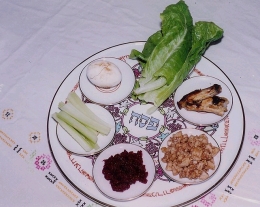
The Pesach Seder is one of the most ritualised times of the Jewish calendar. ‘Seder’ means ‘order’, pertaining to the particular order of this night as prescribed by the Haggadah, a liturgical book read at the Seder meal.
The Seder originates from a description of the Israelites’ preparations before their exodus from Egypt (in Exodus 12:3-11), as well as from the sections that instruct fathers to tell their children the story of the exodus: Exodus 12:26-27; 13:8; 13:14; Deuteronomy 6:20-21.
An important aspect of the Seder is that it is a time for the whole family to be together and for many generations to be present. The purpose of the Seder is for the participants to symbolically experience the exodus together, both young and old.
In order to host a Seder properly, one must have the following: a Haggadah for all present with the story of the slavery in Egypt and how God freed the Jews; a Seder plate with a hard-boiled egg, a roasted lamb bone, greens, bitter herbs, salt water, and haroset (grated apple mixture); spare quantities of these ingredients; wine (at least four cups for each person)(grape juice may be substituted for wine); three pieces of matzah in a three-layered cover; pillows for reclining; a cup (wine glass) set aside for use by Elijah; matzah for all.

Once all the preparation has been done, the host of the night must follow the order of procedure as set out in the Haggadah. The Seder commences with a blessing for the first cup of wine, called kiddush, and the washing of the hands (u’rechatz).
This is followed by the eating of the greens (karpas), which are dipped in salt water. The salt represents the bitter tears of the Israelites, juxtaposed with the green of spring. Then the middle piece of matzah is broken (yachatz). This half is kept for the afikomen. The afikomen is parts of the matzah that are hidden around the house for the children to find. The children are often given gifts for returning it to the host.
Then the telling of the story of Pesach begins, each person having a chance to read from the Haggadah. Sections are sung, and there is generally a lot of interaction between the participants. Once the story has been told, hands are washed again before the meal and a blessing is recited.
A double blessing is said over the matzah (motzi matzah), the top and middle pieces are eaten, and the meal is served. The bitter herbs (maror), usually horseradish, are then eaten and a blessing is said. These evoke the harsh times that the Israelites experienced as slaves. Then a sandwich (korech) is made out of matzah and haroset. Haroset is eaten to remind one of the cement that the Israelites made in Egypt. Now the meal can begin – shulchan orech!
Tzafun is the time to eat the afikomen, once it has been found. The host, who has hidden it, then has to ‘buy it back’ from whoever finds it. Once it reappears, it is broken up and shared for desert.
After all the eating has been done, grace is recited (barech), as well as Hallel (hymn of praise), followed by drinking the fourth cup of wine. Then a cup of wine is poured for Elijah the Prophet and the door is opened to allow him in. More singing follows this. Everyone sings ‘Next year in Jerusalem!’ as a conclusion to the evening (nirtzeh).
The aim of the Seder is to go through the events of the exodus, so that all present are aware of the history and its repercussions. This is further instilled for the following days of Pesach, when one must refrain from eating chametz (leaven) or even owning it.
Related Pages on the BJE Website
How to Prepare a Home for Pesach
Bedikat Chametz (the Search for Leaven)
How to Make Kneidlach (soup dumplings)


